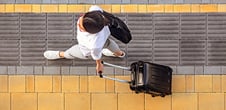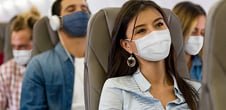 Safety is our #1 priority!
Safety is our #1 priority!
Safety is the highest priority of all involved in aviation. The shared goal is for every flight to take-off and land safely, as happens more than 88,000 times every day. Aviation's 2022 fatality risk of 0.11 means that on average, you would need to take a flight every day for 25,214 years to experience an accident with 100% fatalities. Our Safety Strategy aims to help the industry become even safer.
Safety also relies on passenger behavior and actions. Find out how you contribute to the safety of your flight.
Frequently Asked Questions
How to pack devices with lithium batteries
Many basic devices use lithium batteries: watches, car key remotes, mobile phones, electric toothbrushes, wireless headphones, etc. These can be a fire hazard and should be placed in your carry-on luggage.
- Reduce the amount of devices when you travel. Your airline will have a maximum number they allow onboard and only for your personal use.
- Batteries and power banks with a rating of more than 100 Watt hours (audio/visual equipment, etc.) require airline approval. The battery rating is normally printed on the battery casing.
- If you need to travel with a disability device with batteries such as wheelchair, contact your airline.
- Prevent your devices from becoming damaged or crushed in seats. If you are charging them onboard, monitor them. If they become unusually hot, switch them off and call a cabin crew member.
> More about travel with electronic devices and batteries
Prevent your devices from interfering with aircraft systems
Electronic devices like mobile phones and GPS transmit or receive data. This might cause interference with aircraft systems and lead to safety issues.
You must switch off any transmitting or receiving functions when you board the aircraft. Select your device "flight mode", or switch it off.
Is turbulence dangerous?
Turbulence is when the aircraft encounters a pocket of air that can feel choppy but is perfectly normal. Aircraft are built to withstand a lot of air pushing against them and this is not dangerous to the aircraft. However, turbulence is a major safety concern: each year, a significant number of people are injured by turbulence, while not wearing seatbelts.
This is why you must keep your seatbelt fastened whenever your are instructed to do so, and even simply when you are seated, to avoid injury in case turbulence is encountered without warning.
> Find out what IATA does to help airlines minimize turbulence incidents
Storing your carry-on baggage
Only take what you need for your journey and make sure to comply with your airline’s carry-on baggage allowance.
- Store your bag/s in the overhead lockers, or under the seat in front of you.
- Cabin crew may provide help in finding space for you, but often they aren’t permitted to lift the bag/s for you.
- When putting wheeled bags in overhead lockers: wheels go in first. If possible turn the bag on its side. If not possible, leave it on its back and make sure the locker closes. If it doesn’t close, turn the bag lengthwise inside the locker. Place other items on top to minimize the amount of space your belongings take up.
> All you need to know about baggage when traveling by air
Avoid intoxication and refrain from unruly behavior
Committed by a minority of passengers, unruly incidents threaten safety, disrupt other passengers and crew and may cause delays and diversions. This is why aggressive or unruly behavior is not tolerated onboard for everyone’s safety.
- Consume alcohol in moderation. You can only drink alcohol that has been served by the cabin crew. They may refuse to serve more alcohol if they suspect that you may become intoxicated/drunk. Avoid alcohol if you are taking medications for anxiety, or to help you sleep.
- Do not smoke or vape anything, anywhere onboard.
- Be patient with fellow passengers and the cabin crew.
> Find out about our actions to address unruly passengers issues
Learn and share all you need to know about how to safely travel with lithium battery-powered devices.






